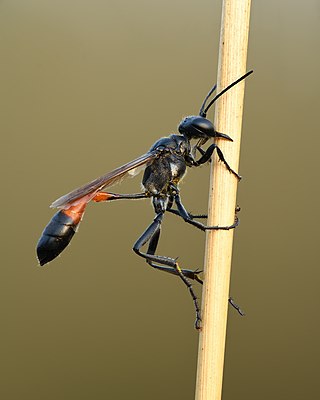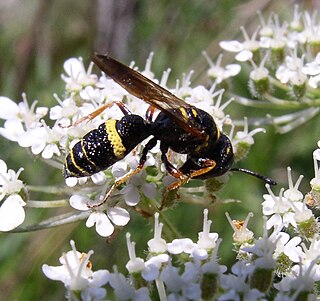
Apocrita is a suborder of insects in the order Hymenoptera. It includes wasps, bees, and ants, and consists of many families. It contains the most advanced hymenopterans and is distinguished from Symphyta by the narrow "waist" (petiole) formed between the first two segments of the actual abdomen; the first abdominal segment is fused to the thorax, and is called the propodeum. Therefore, it is general practice, when discussing the body of an apocritan in a technical sense, to refer to the mesosoma and metasoma rather than the "thorax" and "abdomen", respectively. The evolution of a constricted waist was an important adaption for the parasitoid lifestyle of the ancestral apocritan, allowing more maneuverability of the female's ovipositor. The ovipositor either extends freely or is retracted, and may be developed into a stinger for both defense and paralyzing prey. Larvae are legless and blind, and either feed inside a host or in a nest cell provisioned by their mothers.

Zyzzyx is a monospecific genus of sand wasp, containing a brightly coloured, medium-sized species, Zyzzyx chilensis. It is primarily a predator on flies, but has been observed to consume skippers. "Zyzzyx" is a replacement name proposed in 1937 by V. S. L. Pate for Therapon, originally described by J. Parker in 1929.

The Sphecidae are a cosmopolitan family of wasps of the suborder Apocrita that includes sand wasps, mud daubers, and other thread-waisted wasps.

The emerald cockroach wasp or jewel wasp is a solitary wasp of the family Ampulicidae. It is known for its unusual reproductive behavior, which involves stinging a cockroach and using it as a host for its larvae. It thus belongs to the entomophagous parasites.

The Bembicini, or sand wasps, are a large tribe of bembecid wasps, comprising 20 genera. Bembicines are predators on various groups of insects. The type of prey captured tends to be rather consistent within each genus, with flies (Diptera) being the most common type of prey taken. Nests are typically short, simple burrows, with a single enlarged chamber at the bottom which is stocked with freshly paralysed prey items for the developing wasp larva; the egg may sometimes be laid before the chamber is completely stocked. It is common for numerous females to excavate nests within a small area where the soil is suitable, creating large and sometimes very dense nesting aggregations, which tend to attract various species of parasitic flies and wasps, many of which are cleptoparasites; in some cases, the sand wasps prey on their own parasites (e.g.,), a surprisingly rare phenomenon in the animal kingdom. Although sand wasps are normally yellow and black, some are black and white with bright green eyes.

Philanthus gibbosus, the hump-backed beewolf, is a species of bee-hunting wasp and is the most common and widespread member of the genus in North America. P. gibbosus is of the order Hymenoptera and the genus Philanthus. It is native to the Midwestern United States and the western Appalachians. P. gibbosus are often observed to visit flowers and other plants in search of insect prey to feed their young. The prey that P. gibbosus catches is then coated in a layer of pollen and fed to the young wasps.

A wasp is any insect of the narrow-waisted suborder Apocrita of the order Hymenoptera which is neither a bee nor an ant; this excludes the broad-waisted sawflies (Symphyta), which look somewhat like wasps, but are in a separate suborder. The wasps do not constitute a clade, a complete natural group with a single ancestor, as bees and ants are deeply nested within the wasps, having evolved from wasp ancestors. Wasps that are members of the clade Aculeata can sting their prey.

Craticulina is a genus of true flies in the family Sarcophagidae. They are cleptoparasites of various species of sand wasps. They are ovoviviparous, laying larvae instead of eggs. The larvae share the prey of the sand wasp, and though they are much smaller than the wasps, many fly larvae may be present in each wasp larva, causing food to run short. Sometimes the fly larvae also attack the wasp larvae while they are small, especially if too many fly larvae and too little food are present.

Sphex ichneumoneus, known commonly as the great golden digger wasp or great golden sand digger is a wasp in the family Sphecidae. It is identified by the golden pubescence on its head and thorax, its reddish orange legs, and partly reddish orange body. This wasp is native to the Western Hemisphere, from Canada to South America, and provisions its young with various types of paralyzed Orthoptera.

Structures built by non-human animals, often called animal architecture, are common in many species. Examples of animal structures include termite mounds, ant hills, wasp and beehives, burrow complexes, beaver dams, elaborate nests of birds, and webs of spiders.

Ammophila sabulosa, the red-banded sand wasp, is a species of the subfamily Ammophilinae of the solitary hunting wasp family Sphecidae, also called digger wasps. Found across Eurasia, the parasitoid wasp is notable for the mass provisioning behaviour of the females, hunting caterpillars mainly on sunny days, paralysing them with a sting, and burying them in a burrow with a single egg. The species is also remarkable for the extent to which females parasitise their own species, either stealing prey from nests of other females to provision their own nests, or in brood parasitism, removing the other female's egg and laying one of her own instead.

Pompilus is a genus of spider wasps in the family Pompilidae, the members of which prey on spiders. There are seven species recognised in Pompilus sensu stricto. It is the type genus of the family Pompilidae and the subfamily Pompilinae.

Pompilus cinereus, the leaden spider wasp is the most widespread species of the Pompilus spider wasps, and throughout a large proportion of its wide distribution is the only species of Pompilus. It is the type species of the genus Pompilus and therefore of the family Pompilidae.

Ceropales maculata is a kleptoparasitic spider wasp found in the holoarctic region.

Arachnospila trivialis is a widespread spider wasp of sandy soil areas of the Palaearctic.

Anoplius concinnus is a widespread Eurasian species of spider wasp.

Poecilopompilus algidus is a species of spider wasp which is widespread in the Americas.

Pison spinolae, commonly known as mason wasp, is a solitary wasp of the family Crabronidae, native to Australia and found throughout New Zealand where it is an introduced species.
Ammophila aberti is a species of thread-waisted wasp in the family Sphecidae.

Palmodes occitanicus is a species of thread-waisted wasp in the family Sphecidae.

















